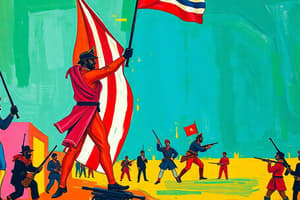Podcast
Questions and Answers
What was one primary cause of the Spanish American War?
What was one primary cause of the Spanish American War?
- Spanish annexation of Cuba
- Cuba's long-standing desire for independence from Spain (correct)
- U.S. acquisition of the Philippines
- Formation of the Rough Riders
Which event directly triggered the U.S. declaration of war against Spain?
Which event directly triggered the U.S. declaration of war against Spain?
- The Battle of San Juan Hill
- Exaggerated newspaper reports
- The explosion of the USS Maine (correct)
- The signing of the Platt Amendment
What was the purpose of the Teller Amendment?
What was the purpose of the Teller Amendment?
- To ensure U.S. control over Cuba
- To annex Puerto Rico
- To support Cuban independence after the war (correct)
- To establish military bases in the Philippines
What was a significant outcome of the Treaty of Paris in December 1898?
What was a significant outcome of the Treaty of Paris in December 1898?
What did the Platt Amendment establish regarding U.S. involvement in Cuban affairs?
What did the Platt Amendment establish regarding U.S. involvement in Cuban affairs?
Flashcards are hidden until you start studying
Study Notes
Causes of the Spanish-American War
- Cuba's independence struggle against Spain since 1895 fueled tensions.
- Sensationalized news coverage by William Randolph Hearst and Joseph Pulitzer, known as Yellow Journalism, amplified public anger towards Spain by exaggerating Spanish atrocities in Cuba.
- The sinking of the USS Maine in Havana Harbor on February 15, 1898, fueled calls for war, although the exact cause remains debated.
- Economic and strategic interests played a pivotal role, with American sugar interests in Cuba and a desire to expand U.S. influence in the Caribbean and Pacific regions driving the U.S. towards intervention.
Key Events of the Spanish-American War
- President William McKinley declared war on Spain in April 1898, marking the beginning of the conflict.
- The Battle of Manila Bay (May 1, 1898) saw the U.S. Navy decisively defeat the Spanish fleet in the Philippines, giving the United States control of the Pacific.
- The Battle of San Juan Hill, a significant land battle during the war, took place on July 1, 1898. Theodore Roosevelt led the Rough Riders, a volunteer cavalry unit, in a key charge that ultimately helped secure victory for the U.S.
- The Battle of Santiago de Cuba, fought in July 1898, saw the U.S. Navy destroy the remaining Spanish fleet in the Caribbean Sea, ultimately ending the Spanish threat in the region.
- Spain surrendered to the United States on August 12, 1898, ending the war officially.
Legislation and Aftermath of the War
- The Teller Amendment, passed in April 1898, declared that the United States would not annex Cuba after the war, reassuring Cuban independence.
- The Treaty of Paris, signed in December 1898, formally ended the Spanish-American War. Spain ceded Puerto Rico and Guam to the U.S., Cuba became a protectorate, and the Philippines were purchased for $20 million. This marked the beginning of U.S. colonial expansion.
- The Platt Amendment (1901) imposed restrictions on Cuba's sovereignty and established a U.S. naval base at Guantánamo Bay, effectively turning Cuba into a U.S. satellite state.
Impact of the Spanish-American War
- The Philippine-American War, a brutal conflict between 1899 and 1902, followed as Filipino nationalists resisted U.S. control, leading to a bloody struggle for Philippine independence.
- The war propelled the United States into a new era of global power, challenging the dominance of European powers and expanding U.S. influence in the Western Hemisphere and Asia. This contributed to the rise of the United States as a major global power.
Studying That Suits You
Use AI to generate personalized quizzes and flashcards to suit your learning preferences.




